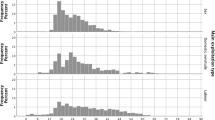Abstract
Under California law, local governments may authorize pharmacies within their jurisdictions to sell ten or fewer syringes to an adult without prescription, proof of identity, or proof of medical need. Local governments may simultaneously exempt adults from prosecution for violation of state drug paraphernalia codes for possession of ten or fewer syringes for personal use. Both of these provisions are temporary and sunset on December 31, 2010, unless subsequent state legislation amends that date. The objective of our study was to ascertain how and why local policymakers made their decisions regarding non-prescription syringe sale (NPSS). We examined influences on their decisions, including specific messengers and the arguments that were most salient to their decision making. We selected jurisdictions that were geographically representative of California counties; those with and without syringe exchange programs, and those that had passed or rejected NPSS. We conducted nine semi-structured interviews in five jurisdictions. To enrich primary data collection, we analyzed secondary data by reviewing audio, video, and written transcripts of public hearings and newspaper coverage in five jurisdictions, including three jurisdictions without primary interview data. Among proponents of NPSS, we identified common themes, including: (1) public health research provided conclusive evidence for reduction in HIV and hepatitis transmission without problems of crime, drug use, or unsafe discard of syringes; (2) the local health officer was the key to influencing local policymakers; (3) recall of prior debates over syringe exchange served to inform their decision making; and (4) a lack of local opposition or controversy. Common concerns among opponents of NPSS included: (1) that there would be an increase in unsafe discard of syringes; (2) loss of an important law enforcement tool; (3) that drug users were incapable of desired behavior change; and (4) that research was inconclusive, or proved that syringe access would not work in reducing rates of disease. Themes held in common by proponents and opponents of NPSS were identified as well. Syringe access through NPSS is in fact supported by a robust body of public health research and is considered an important component of a comprehensive strategy to reduce HIV and hepatitis transmission. Our study highlights the importance of understanding the perspectives of elected officials in order to ameliorate their concerns without undermining the public health goal of reducing death, disease, and suffering in at-risk communities.
Similar content being viewed by others
Notes
The narcotics officers’ lobbyist was incorrect. An example of expert analysis provided to all California State Senate Health Committee members can be found at http://info.sen.ca.gov/pub/03-04/bill/sen/sb_1151-1200/sb_1159_cfa_20040308_162038_sen_comm.html
References
Legislative Counsel Office of the California State Legislature. Business and Professions Code, Section 4140–4149. Available at: http://www.leginfo.ca.gov/cgi-bin/waisgate? WAISdocID=53519425183+0+0+0&WAISaction=retrieve. Accessed on: December 26, 2008.
Legislative Counsel Office of the California State Legislature. Health and Safety Code, Section 11364–11376. Available at: http://www.leginfo.ca.gov/cgi-bin/waisgate? WAISdocID=53537126350+0+0+0&WAISaction=retrieve. Accessed on: December 26, 2008.
California State Senate website. Available at: http://info.sen.ca.gov/pub/03-04/bill/sen/sb_1151-1200/sb_1159_bill_20040920_chaptered.html. Accessed on: December 28, 2008.
Rose V, Backes G, Martinez AN, McFarland W. Non-prescription syringe sales in California: a qualitative examination of practices among 12 local health jurisdictions. J Urban Health. 2010. doi:10.1007/s11524-010-9445-5.
Patton MQ. Qualitative research and evaluation methods. 3rd ed. Thousand Oaks: Sage; 2002.
Fuller CM, Ahern J, Vadnai L, et al. Impact of increased syringe access: preliminary findings on injection drug user syringe source, disposal, and pharmacy sales in Harlem, New York. J Am Pharm Assoc. 2002;42(Suppl 2):S77-S82.
Fuller CM, Galea S, Caceres W, Blaney S, Sisco S, Vlahov D. Multilevel community-based intervention to increase access to sterile syringes among injection drug users through pharmacy sales in New York City. Am J Public Health. 2007;97(1):117-24.
Raboud JM, Boily MC, Rajeswaran J, O’Shaughnessy MV, Schechter MT. The impact of needle-exchange programs on the spread of HIV among injection drug users: a simulation study. J Urban Health. 2003;80(2):302-320.
California Syringe Access. SB 1159 Resource Library. Available at: http://www.syringeaccess.com. Accessed on: May 22, 2009.
World Health Organization. Policy brief: provision of sterile injecting equipment to reduce HIV transmission. Geneva: WHO; 2004.
Centers for Disease Control & Prevention. Fact Sheet Series: State and Local Policies Regarding IDUs’ Access to Sterile Syringes; December, 2005. Available at: http://www.cdc.gov/idu/facts/aed_idu_Pol.htm. Accessed on: February 26, 2010.
Center for Health Improvement. Policy Brief: Syringe Exchange in California: Policies, Programs and Progress. Sacramento; August 2007.
State Senate Health Committee Analysis of AB 518 (Mazzoni) Needle Exchange Programs. 1999. Available at: http://info.sen.ca.gov/pub/99-00/bill/asm/ab_0501-0550/ab_518_cfa_19990614_151229_sen_comm.html. Accessed on: December 26, 2008.
Funded by
California HIV/AIDS Research Program, CR05-PHFE-801/CR05-SANE-802; 2005–2007.
Author information
Authors and Affiliations
Corresponding author
Rights and permissions
About this article
Cite this article
Backes, G., Rose, V.J. Primary and Secondary Analysis of Local Elected Officials’ Decisions to Support or Oppose Pharmacy Sale of Syringes in California. J Urban Health 87, 553–560 (2010). https://doi.org/10.1007/s11524-010-9442-8
Published:
Issue Date:
DOI: https://doi.org/10.1007/s11524-010-9442-8



